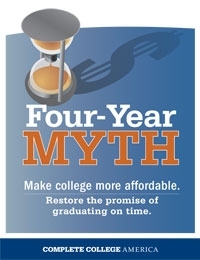
19 Jan The College Myth: Why Most Students Need More Than Four Years
by Joanna Pulido
The teacher smiled and held a hat as a line of about a dozen students looked at each other nervously. Inside the hat were small pieces of paper with each student’s name. Luck would determine who would be part of the class, and who would have to continue the search.
Those of us already enrolled in the class waited quietly, watching the smiles and frowns as lucky students moved closer to graduation, and others possibly further. In my four and a half years at San Francisco State University, I saw this scenario play out year after year. Some teachers tried to help us by taking into consideration the number of credits students needed, or by adding more students to the class than the limit stipulated — but often times getting into a class just felt like a matter of luck.
This phenomenon isn’t unique to SFSU, in many universities across California it’s difficult for students to graduate on time because of the space constraints in required classes, tuition costs, credits lost when transferring schools and generally not enough courses offered. And, a new study shows that the commonly held goal of graduating within four-years is unattainable for a growing number of students.
Four-Year Myth, a report from the national nonprofit, Complete College America, declares that a 4-year degree has become a myth in American higher education. The study finds that the majority of full-time American college students do not graduate on time, costing them thousands of dollars in extra college-related expenses.
Policy experts who analyzed the statistics believe a more realistic benchmark for graduation is six years for a bachelor’s degree and three years for a “two-year” certificate.
While in college I heard numerous friends and students debate whether higher education is worth the debt. It’s difficult to maintain an optimistic outlook with increasing tuition costs, long commutes and a bleak job market for graduates.
Fellow students frequently bowed to the pressure of not wanting to fall too deep into debt and would work part-time or full-time while in school, which usually meant extending their time in school. Not a great tradeoff.
Ideally, students would be able to make classes fit into the demands of the rest of their lives. As is, it works the other way around. Students are given a day and time to register for classes depending on a number of variables: what year of school they’re in, whether they’re athletes or in a special program because of disabilities or income level. Often, popular classes—and even those needed for graduation—fill up fast. Imagine being given a day and time to register only to discover that the classes you need are already full, with a full wait list too. This is the frustrating reality for many students.
We are told that education is the way to success and better lives, but for many it becomes a stressful cycle and may not guarantee anything more than years of debt and an unfinished dream.
As a solution, Complete College America suggests a more structured higher education delivery method, called Guided Pathways to Success (GPS), which would provide students with a direct route to graduation. Utilizing GPS, majors are organized into a semester-by-semester set of courses that lead to on time graduation.
My first two and half years at SFSU, I played for the women’s soccer team, which helped me obtain priority registration, and due to my low income background I was part of the EOP (Educational Opportunity Program), which also offered priority registration. Both of these programs also provided tutoring, counseling, money for books and guidance. To stay in these programs I had to keep a 2.0 GPA and complete 12 units each semester, which kept me on track for graduation.
Ultimately, these structured programs helped me complete classes, save money, and provided moral support that made me feel more confident in my college experience. If in practice, GPS functions the way the programs I was part of did, it may very well prove to be the answer to the increasing time and costs of college.






No Comments